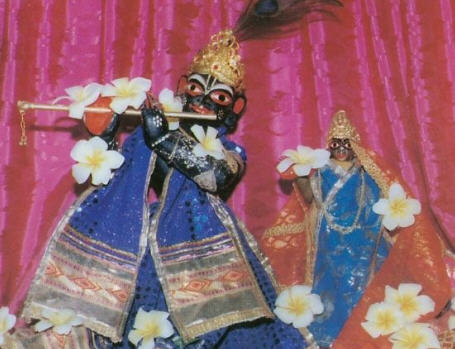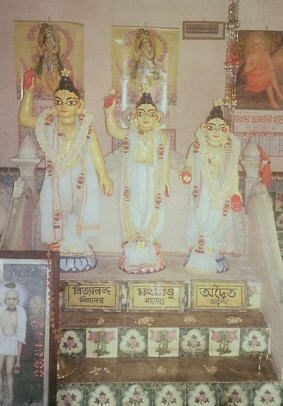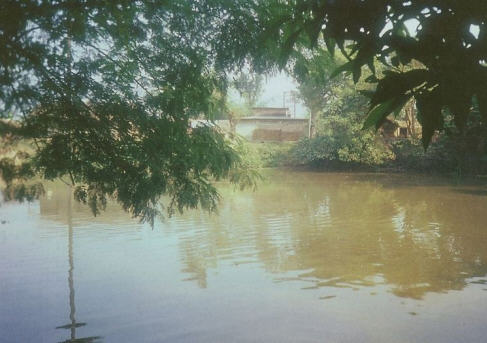
Sri Radha Madana Mohana
Two leaders of Lord Caitanya's movement once lived here as ministers to the Muslim ruler.
RECENTLY I FULFILLED a long-cherished desire to visit Ramakeli, in northern West Bengal. It was once home to Rupa Gosvami and Sanatana Gosvami, direct disciples of Lord Caitanya and leaders in His Hare Krsna movement. Ramakeli is a small village, where groups of cows and goats are more common than cars on the dusty roads. There are no shops, and water is available only from hand pumps. It appears that little has changed here for hundreds of years.
I stayed with friends at the home of Amalendranath Maitra, a well-known advocate in nearby Malda. He arranged a car to take us on a tour of Ramakeli, some fifteen kilometers from Malda.
We arrived at the gateway of the Radha-Madana-Mohana temple, founded by Rupa and Sanatana and later managed by their nephew Jiva Gosvami, another pillar of Lord Caitanya's movement. After Jiva left to join his uncles in Vrndavana, the area became plagued with cholera. The deities were kept closed within the temple until Jitendranath Maitra, in the disciplic line from Jiva Gosvami, started the worship again three hundred years later.
In 1930, Amalendranath Maitra's father, Upendranath Maitra, came to Ramakeli, and the local people, who were very poor, asked him to repair the temple. He told them he would go home and think about it. That night he dreamt of Radha-Madana-Mohana, who asked him to build a new temple for Them. Without hesitation Upendranath Maitra arranged for all the building materials, and within a month a new temple was built.
From Ministers to Goswamis
As we sat looking at the beautiful deities of Radha-Madana-Mohana, the head priest, Purna Chandra Panigrahi, related the following history of Rupa and Sanatana:

Five hundred years ago the area was governed by the Muslim ruler Nawab Hussein Shah, who controlled Bengal, Orissa, and Bihar. At that time Rupa and Sanatana (then known as Amara and Santosh) were living in Ramakeli. They were highly respected in the brahmana community. Noting their incredible intelligence, the Nawab forced the brothers to work in his government. He made Rupa his treasurer and Sanatana the prime minister. The government thrived under their expertise, and in appreciation the Nawab showered them with immense wealth.
Being great devotees of Krsna, Rupa and Sanatana cared nothing for their wealth and positions and yearned for the time when they would be freed from their predicament. They frequently wrote letters to Sri Caitanya Mahaprabhu, asking for His help so that they could dedicate their lives to Him.
In 1514, Lord Caitanya, on the excuse of going to Vrndavana, visited Ramakeli only to see His eternal associates Rupa and Sanatana. He was accompanied by thousands of devotees. He initiated the brothers and told them that Krsna would soon release them from their government posts.
Rupa and Sanatana had been living at the Nawab's house, but after meeting Lord Caitanya they started worshiping the deities of Radha-Madana- Mohana and lived near Them. They could no longer tolerate working for the Nawab. Rupa gave his wealth to his family and the brahmana community and made his way to Vrndavana.
Sanatana, being the prime minister, stayed for some time but told the Nawab he was too sick to work. The Nawab became suspicious and sent his doctor to find out what was wrong. When the doctor arrived at Sanatana's house, he saw that he had made it into a devotional ashram with daily scriptural classes going on. The Nawab was furious. Seeing that Rupa had already left, he ordered Sanatana to do more work for him. When Sanatana told him he was now resigning, the Nawab had him imprisoned.
Meanwhile, in Vrndavana, Rupa Gosvami dreamt that Sanatana was in jail. He managed to get a letter to him informing him that he had deposited ten thousand gold coins with a local shopkeeper for the service of devotees. With seven thousand of these coins, Sanatana was able to bribe the jailkeeper to release him, enabling him to join Lord Caitanya. Jiva Gosvami joined Rupa and Sanatana later, after the death of his mother.
Gupta Vrndavana
When the priest finished his narration, we were served maha-prasadam, food offered to the deities, on banana leaves. After lunch we went to see Radha Kunda and Syama Kunda, two lakes next to the temple. Rupa and Sanatana built the lakes, replicas of Radha Kunda and Syama Kunda in Vrndavana, to use their wealth and pacify their minds in separation from Vrndavana. The area surrounding the lakes is known as Gupta ("Hidden") Vrndavana. I filled a small container with sacred soil here as a souvenir.
The main priest then took us to see the sitting place of Lord Nityananda, which faces two trees. The larger tree is said to be six hundred years old and is next to a tiny temple containing Lord Caitanya's footprints. The other tree was grown from a branch of the tree under which Lord Caitanya initiated Rupa and Sanatana and their brother Vallabha, who became Anupama. Jiva Gosvami, then a young boy, hid behind a tree, watching. Nearby stands a temple of a beautiful deity of Lord Caitanya worshiped by Jiva Gosvami.
Around Ramakeli

Syama Kunda
After thanking the priest for showing us all these places, we went back to the car to see the rest of the village. Ramakeli is very beautiful, covered with lush vegetation interspersed with many tranquil lakes and thatched cottages. The area has been famous since ancient times for silk and excellently savored mangoes. Coconut trees and date palms tower gracefully above the other greenery.
We passed the remains of Nawab Hussain Shah's government building. His horses and elephants would graze on the expansive grassy slope nearby.
A short ride along the road brought us to the prison where Sanatana Gosvami was held. Slowly making our way through the many cows grazing outside, we entered the building. The inside shape reminded me of the Radha-Govinda temple in Vrndavana. The tall building with its arched brick ceiling was built without any supports. Modern builders are baffled at how it stays up. Walking back outside, I was thinking how Sanatana Gosvami would have come through the same doorway to be released after spending seventeen months and nineteen days inside.
Ramakeli got its name to commemorate a visit by Lord Rama. Our last stop was the lake where Sita, the wife of Lord Ramacandra, performed pinda (oblations for departed souls) for her mother. Nearby is a tree said to be five thousand years old. Many thousands of people come once a year from Bihar to perform pinda here and worship the tree, known as Bala Briksha. It is certainly the largest tree I have ever seen, with fronds hanging from huge branches almost to the ground.
As we drove back to Malda, I considered how fortunate I was to have visited this village touched by the feet of Lord Caitanya. Here He recruited three towering spiritual figures: Rupa Gosvami, Sanatana Gosvami, and Jiva Gosvami. They built the foundation upon which the present Krsna consciousness movement was built. All of us who have been blessed by this movement are eternally indebted to them.
Vrndavani Devi Dasi joined ISKCON in 1980. She lives with her family near Bhaktivedanta Manor in England and handles the mailing of Back to Godhead to our readers in the U.K.
